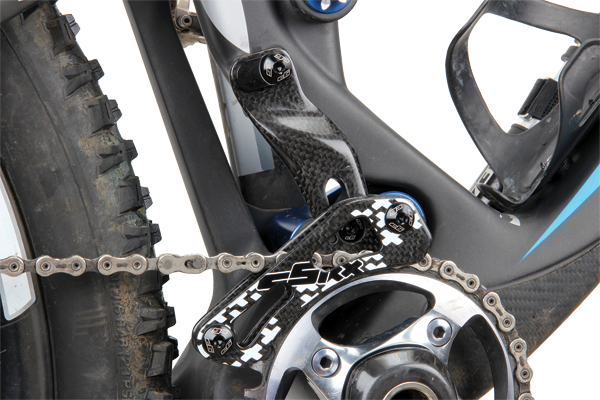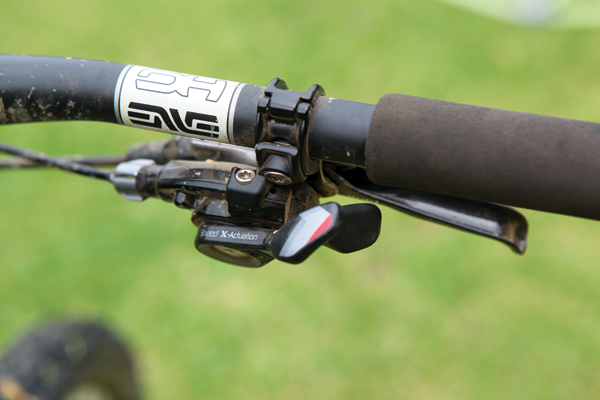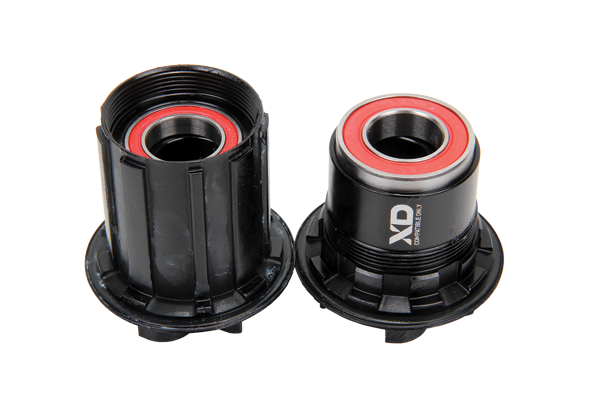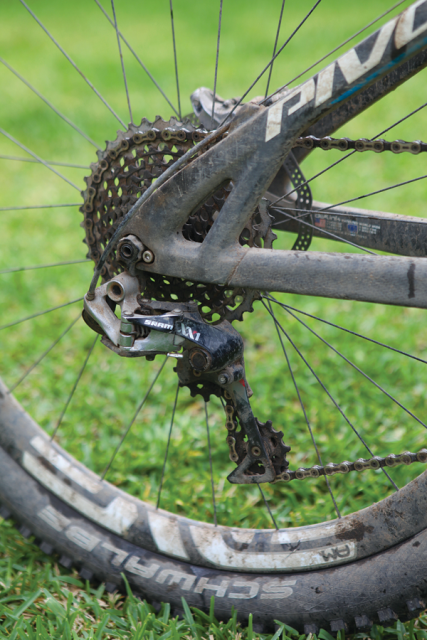SRAM XX1
 After five months on the trail, we take an in-depth look at this new single-chainring 11-speed group and see how it fares in the real world.
After five months on the trail, we take an in-depth look at this new single-chainring 11-speed group and see how it fares in the real world.
In recent times SRAM been very successful with identifying market trends and capitalising on them. Five or six years ago, many XC racers were modifying their drivechains, removing the granny gear and fitting two moderately sized chainrings—the result was a 2x9 drivechain. SRAM took this concept and improved on it. By adding a wide range 10-speed MTB cassette, their XX drivechain offered the simplicity that many desired along with a broader gear range that made it a viable option for recreational trail riders too. Now SRAM offers 2x10 drivechains at all different price points and their main competitor has also followed suit to answer the demand.
A similar process lead to the creation of the new XX1 component group. For many years, gravity-oriented riders have been running a single front chainring with a chain retention device to prevent chain loss in rough terrain. Strong-legged XC riders have also gone down the single-ring path to simplify and make their bikes lighter. Recognising a potentially diverse market, SRAM set out to refine the concept and create a dedicated single-ring drivechain. Sure, there have been dedicated single-ring groups in the past, but they’ve been designed purely for the gravity side of the sport. SRAM’s goal here was to create something truly versatile.
While running a single chainring can improve reliability and ease of use, it inevitably falls short in the total gear range on offer. On its own, a regular 10-speed 11/36 cassette gives you a 330% range in gear ratios. The same cassette on a 2x10 drivechain has a 470% gear range and you’ll get a 530% range with a triple. SRAM’s new 11-speed 10/42 cassette achieves a 420% gear spread, so you get a total gear range that’s a good deal closer to a multi-ring drivechain, whilst retaining the simplicity and reliability benefits of a single ring setup.
Engineered as One
The concept is simple enough but there’s a lot more to XX1 than slapping on a wide-range cassette and tossing your front derailleur in the bin. The wide-range cassette is part and parcel of the system and the 10-tooth cog is simply too small to fit on a regular 9/10-speed freehub body. Sure, they could have stuck with an 11-tooth top gear but you’d then need to go bigger at the opposite end of the cassette, and the 42-tooth climbing gear is already comically large—it’s a good deal bigger than a 160mm brake rotor.
Faced with this dilemma, SRAM decided to redesign the cassette body to suit their 11-speed cassette. Called the XD driver body, it only has splines on the inner portion—they sit directly under 42-tooth dinner plate. The outer part is smooth and steps down in diameter to fit the 10-tooth cog. While it’s no longer compatible with regular cassettes, the dimensions are close enough that most hub and wheel manufacturers can design an XD-style freehub body to suit. Manufacturers currently offering XD drivers include; SRAM, Mavic, DT Swiss, Bontrager, Specialized, Syncros, Easton, Stan’s, Hope, FRM, Tune, Novatec, Crank Brothers, Roval, American Classic, Giant and Acros (go to www.xddriverbody.com for updates). In most cases it will be a simple bolt-on modification, although I can’t see Shimano rushing out to provide an XX1 compatible freehub anytime soon!
Mounting the XX1 cassette is easy. Ten of the 11 cogs are machined from a single block of steel. The alloy 42-tooth cog links the others to the hub and the whole assembly mounts as a single unit—you simply can’t get it wrong. It’s tightened with a regular cassette tool and removal requires a chain whip as well—just like any normal cassette.
Taking it to 11
Put an XX1 cassette next to a regular 10-speed unit and it’s about a full cog-space wider. To shoehorn this in, you’d expect to find a wider axle (creating compatibility problems) or more offset on the hub, which would make the back wheel weaker. Cleverly, SRAM manages to squeeze in all 11 cogs without altering the axle width or messing with the spoke tension. It’s done by dishing the 42 cog so the teeth sit further inboard. This could have put the chain very close to the spokes, but the huge diameter of the XX1 cassette means the derailleur sits well away from the wheel. At the opposite end, the 10-tooth cog sits a fraction closer to the frame, but the hidden lock ring means there’s sufficient clearance. For something that’s a fairly radical departure from current 10-speed drivechain, SRAM has done well at making it mesh easily with current generation wheels and frames. The main compatibility issue lies with the need for an XD driver body, but wheel manufacturers are hopping on board pretty quickly with this.

As you’d expect, XX1 requires a special chain. The 11-speed cog spacing is a fraction tighter and the outer chain plates are narrower to suit. Internally it has the same spacing as a 10-speed chain and you can’t pick the difference by eye when they are placed side-by-side. SRAM claims the XX1 chain is actually stronger than its 10-speed counterpart, as the plates aren’t bevelled and chamfered to augment front shifting duties. It also features a new hard coating that’s said to improve durability.
Voodoo Teeth & Chains
Squeezing the wide-range cassette onto the back wheel was only half the battle with developing XX1—chain retention is the other key part of the puzzle. On a multi-ring drivechain, the chainring teeth are cut down in height with ramps and gates that are specifically designed to derail the chain. The front derailleur acts as a default chain guide and without it the chain would fall off constantly. It certainly isn’t optimal and dropped chains are common enough.
Most good one-by conversions include a single-specific chainring with deep-cut teeth, but they still need a chain device to keep the chain on, even with a clutch-style rear derailleur. For XC use it’s usually just a top guide. For rougher trails an under the chainstay guide is added and downhillers run very comprehensive guide setups.
SRAM suggests that XX1 can be ridden off-road with no guide at all. It’s a lofty claim but they’ve clearly gone to great lengths to make it work. The unique teeth on the XX1 chainring are deeper than other single-specific rings and they alternate in thickness to match the inner width of the chain. This aims to snug-up the fit with the chain and reduce the chance of sideways derailment when you’re hitting rough trails.

The unique XX1 derailleur also plays a role. It employs a strong spring with a really tight clutch and the oversized jockey wheels share the same ‘X-Sync’ alternating tooth profile as the chainring. However, the real point of difference lies within the derailleur parallelogram. Rather than moving diagonally to match the slope of the cassette, it moves horizontally and stays parallel to both the ground and most bump forces—this makes it more stable and less likely to bounce around. As the parallelogram no longer follows the cassette, SRAM offsets the upper jockey wheel so it moves up and down, keeping an even distance away from the cogs. This design will only work with a single chainring setup but that’s what XX1 is all about!
Less is More
SRAM didn’t build XX1 to appease the weight weenies. Despite this, XX1 is 153g lighter than a SRAM’s XC-race focused XX 2x10 drivechain and it saves around 230g compared with an XTR triple. The weight loss simply comes from having fewer components; individually the parts were designed to be robust enough for all-mountain and gravity-enduro use. That said, weight clearly mattered to the engineers—one look at the amazing one-piece, hollowed out ‘X-Dome’ cassette will tell you that. With 11 gears and the immense 42 tooth cog, our sample weighed just 267g—that’s actually a few grams lighter than a Shimano XTR 10-speed cassette! With a regular GXP bottom bracket, the cranks came in at 673g—not featherweight but still 26g less than a SRAM XX double. At 241g, the rear derailleur is almost portly (XX is 181g) but the total lack of a front derailleur, shifter and cable more than makes up for it. The low overall weight and healthy gear spread ensures that you’ll be seeing plenty of XX1 on the XC race scene.

SRAM has pulled together some really cool ideas with the XX1 drivechain but it also raises plenty of questions. Things like; is the gear range wide enough when tackling big hills, does the chain really stay on and will the 11-speed chain survive in the dirty world of mountain biking?
Duelling Rings
Let me get this out there from the beginning; I remain a big fan of the good old triple. These days many scorn the triple, saying you don’t need that many gears, there are too many overlapping ratios and if the hill is steep enough to need a 24-36 you may as well walk.
For me the triple works for two reasons; first off I don’t care if walking is faster—I bought my bike to ride! Attempting to ride up steep stuff is all part of the challenge and with a bit of balance and technique, you stand a better chance with a proper granny gear.
The other great thing about a triple is the 32-tooth middle chainring. On my local trails it provides the perfect intermediate gear range that gets you just about everywhere; uphill, flat and undulating trails are all tackled comfortably in the middle chainring. Of course you’ve still got a really low bailout gear and a proper big ring at your disposal, but most of the time I won’t touch the front shifter. A triple also means you are prepared for anything, no matter where you ride—from Rotorua to the Alps, a triple has you covered.
When riding 2x10 on my local trails, I find the smaller chainring is too low for anything but climbing. This encourages me to stay in the big ring more, but I’ll often wind up cross-chaining in search of an easier gear. It’s like the big ring is too big and the small too small for a lot of my trail riding. Of course 2x10 is great in other areas; ride at Daisy Hill, Taree, Forrest or Sparrow Hill and the moderately sized big ring is ideal. In my book there is no right and wrong when it comes to gearing, it’s just got to suit you and your trails.
With XX1 there are no issues with cross-chaining, redundant gears or complexity; you just choose a chainring to match your trails. For me that meant running a 30 or 32-tooth ring up front. In this regard it’s like having the cosy and comfortable middle ring from a triple, just with an extra gear ratio at either end of the cassette. If your trails are fast and flowy with no steep and long climbs, you may opt for a 34 or 36-tooth ring. SRAM offers six chainring options in even numbers from 28 through to 38 teeth, so there’s a good range of gearing options to suit both 29ers and 26-inch riders.
Swapping between chainrings is extremely fast and easy. SRAM didn’t introduce an all-new XX1 specific 76PCD chainring format to make life difficult for bike shops and small aftermarket manufacturers. The bolt circle had to be smaller than the common 94PCD to fit the smaller chainring options and the bolts are also offset to clear the wide carbon crank arms. It’s designed so you can swap chainrings without removing the cranks; all you need is a 5mm allen key and a spare two to three minutes. With most bikes you should be able to choose from two to three chainring sizes without altering the chain length. If you run a 32-tooth up front, you may be able to swap to a 30 for a ride with more climbing or a 34 for a flatter ride, all with the same chain. Running a 36 on the same bike will probably require a longer chain.
As with SRAM’s 10-speed chains, XX1 uses a PowerLock tool-free joining link (albeit an 11-speed specific one). While this makes joining and chain removal easy, the PowerLock is a single use item. If you plan on keeping a long and a short chain on hand to suit radically different chainring sizes, you’ll need a fresh joiner for each time you swap (they sell for around $10 each).
With a 32-tooth chainring, first gear is almost the same as second lowest gear on a 3x10 drivechain (24/32). Top gear is very close to the second highest on a triple (42/13)—for me this gear was comfortable for speeds up to 35-40kp/h. In effect, you really only lose two and a half gears when compared to a 30-speed drivechain. Compare it to a 2x10 drivechain and XX1 comes closer still.

With XX1, most gearshifts yield a very ‘normal’ change in the ratio (between 12-16% difference). The only exception comes with the jump from the 10 to the 12 cog. It creates a 20% change which can be disruptive to your pedalling, sometimes leaving you with a gear too high or one that’s too low. With my smallish 32-tooth front ring, I was more likely to be swapping between the 10 and 12 cogs on open and fast trails. In these situations (as well as on the road) the jump in ratios did prove annoying. This minor glitch aside, XX1 does a truly admirable job; it offers a consistent spread of ratios with a total gear range that’s amazing for a one-by drivechain.
Virtues of Being Single
My trails are quite varied and I do use the entire gear spread offered by a triple. Despite this, I’m seriously considering a full-time move to 1x11. It may fall short of a multi-ring drivechain in its total gear range but there’s a whole lot to like about XX1.
To start with, it’s an impressively clean-looking setup and I love how uncluttered my handlebars are—even with a dropper post remote. Combine this with a matchmaker-style mount (if you run Avid brakes and a Reverb dropper) and you’ll get an even tidier finish. The massive cassette does look a bit odd next to the comparatively small front ring but over time I got used to its appearance.
When you hit the trail, the next thing you’ll notice is the silence. Clutch-style derailleurs really helped with reducing chain slap on regular MTB drivechains but you still get noise from the chain rattling against the front derailleur cage and adjacent chainrings. With XX1 there is none of that; it’s almost like riding a single speed, except that you’ve still got 11 gears—awesome!
I was able to try XX1 with both Gripshift and trigger shifters. Both offered a really light and crisp shift action that made gear changes positive and easy. Changing gears under load was a breeze and having access to your entire range via one shifter was fantastic. While I generally prefer trigger shifters, the Gripshift option worked particularly well with XX1. It allowed you to sweep across the entire cassette in one go, where the triggers would only take you across five cogs with a full-length push of the main lever. Of course, chainring shifting has always been the weak link in the traditional MTB drivechain, and that’s no longer a consideration. In most cases you will gain extra chainring clearance too; so you’re less likely to bash the chainring when attempting to clear log hops and roll-overs.
There was one chink in the silence that will go unnoticed by most. As mentioned earlier, XX1 runs a strong spring with a particularly tight clutch in the rear derailleur. It resists movement, keeping the chain taut and virtually slap free. When it is forced to move, it does so with a ‘knock’. With many modern suspension bikes, the chainstays get longer as the suspension is compressed. This lengthening pulls on the derailleur cage and you may feel the knocking through the frame or drivechain—it can feel a little like a worn shock eye bush. It’s not something that you’ll feel when bombing through rock gardens at speed but it may be noticeable when clambering up ledges when climbing. Naturally this won’t be a problem on hardtails, or duallies that employ minimal chain growth.
It’s worth noting that the move to a single chainring can affect the level of ‘anti-squat’ on suspension bikes. Inefficient pedalling bikes that suffer with excessive suspension squat can actually benefit from a traditional 2x10 or 3x10 drivechain—the small inner chainring or granny gear generally gives the suspension system more anti-squat to resist pedalling bob when climbing. Efficient bikes shouldn’t have any problems in this regard; in fact some riders may prefer the reduction in pedal kick-back that you’ll get when climbing in the larger front chainring of the 1x11 drivechain. Altering the drivechain format can certainly influence the pedalling performance on suspension bikes; whether the change is positive or not will depend on the bike as well as individual rider preferences.
Chain Retention
The big question for many is; does the chain stay on without a guide as SRAM suggests? Our XX1 group was fitted to a 150mm travel trail/all-mountain bike and ridden aggressively over all types of terrain. We tried backpedalling over the bumps as well as descending in the 10-tooth cog to test the worst case scenario chain tension and chain line. Despite our efforts the chain stayed put in situations that would have derailed a multi-ring drivechain. In five months of riding, the chain did come off on three occasions; twice on the same day when racing a super-D event and once on a trail ride. In every case, the riding was more at the DH end of the spectrum—the super-D itself was on a fully-fledged DH race track. XX1 may be versatile but it’s not designed for downhill racing. That said, the lines between DH racing and ‘gravity enduro’ can get blurry at times. I feel that XX1 is totally capable of running guide-free for trail and all-mountain use, but if you ride more at the aggressive DH end of things, I’d suggest that using a simple top-mounted guide would be worthwhile.
Durability
Every time a manufacturer adds extra gears to the rear cassette, fears arise over drivechain durability. With XX1 however, the chain no longer has to perform the extremely stressful task of shifting between chainrings. The rear cassette may be wider but the chain no longer has to run through the same range of diagonal angles as encountered with a multi-ring drivechain. Finally, the deep and wide teeth that help to retain the chain also have more meat there to resist wear. Every aspect has a knock-on effect; if the chainring lasts longer, the chain will too. With less chain wear you get more life out of the cassette and on it rolls.
Varying trail conditions and soil types dramatically affect wear rates, so it’s near impossible to compare, but after five-months of riding XX1 seemed to be coping better than a regular drivechain. While the anodising had rubbed off the front teeth and the chain clearly had a bit of wear, it wasn’t yet at the point where you’d need to replace anything. There was certainly none of the ‘chain lift’ that you commonly get on the multi-ring setup, where the chain creeps up and rides high on the chainring when placed under load.
The Future of 1x11
Aside from the simplicity, the silence and the all-round improvement in reliability, eliminating the front derailleur can really open up the options for frame designers. The additional clearance can be used to put shorter chainstays on a 29er and there can be more room for fat tyres. Suspension systems can get more creative with fewer restrictions on pivot placement if there’s no need for a derailleur mount. I doubt we’ll see too many manufacturers eliminating the front derailleur mount altogether, as there are still trails and riders that need a wider gear range, but 1x11 will allow some frame builders to get a little more creative with their designs.
For the moment the number one hurdle for most potential XX1 buyers is likely to be the price. A complete drivechain sells for around $1,650 (GXP cranks, shifter, derailleur, cassette and chain) but the real killer is the individual cost of some wear items—like the $449 rear cassette for example. Get your XX1 derailleur munched by a stick? That’ll be $349 thanks! At least the chain is sensibly priced—it sells for $69. SRAM may have launched their 1x11 concept at the very top end of the market but it’s likely to filter down to more affordable price points soon enough. They launched 2x10 with the equally pricey XX groupset and within 18 months it had filtered down to the very workmanlike X.7 group. We can’t say for sure but we’ve certainly heard rumours brewing that XX1 will follow a similar course. Our most dependable source says that 1x11 will probably go down to X.0 level for 2014 but we’ve also heard random rumours that the OEM demand has prompted SRAM to move it down to an X.7 level. One thing’s for sure, 1x11 will be very popular once it becomes available at a lower price-point.
SRAM really nailed it when they introduced the 2x10 concept; they read what the market wanted and delivered it with a much-improved, purpose-built package. I feel that XX1 has done it all over again. There’s already a sizable demand for single chainring drivechains and XX1 should tap straight into that market. It offers the simplicity and robustness that people desire without the need for add-on guides and retention devices. Further to this, it broadens its appeal with a really solid spread of gears that’s sure to entice riders who previously wouldn’t have considered a single ring setup. SRAM states that XX1 isn’t designed to make multi-ring drivechains redundant – they still hold a place with those who need a really wide gear spread – but we can see 1x11 turning into a very popular option for XC racers, gravity enduro riders and just about anyone in between.
Monza Imports (03) 8327 8080 / www.sram.com


 After five months on the trail, we take an in-depth look at this new single-chainring 11-speed group and see how it fares in the real world.
After five months on the trail, we take an in-depth look at this new single-chainring 11-speed group and see how it fares in the real world.



